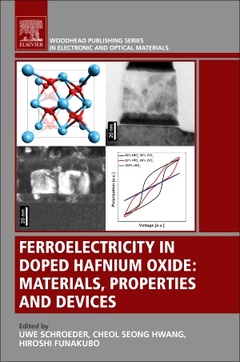Description
Ferroelectricity in Doped Hafnium Oxide
Materials, Properties and Devices
Woodhead Publishing Series in Electronic and Optical Materials Series
Coordinators: Schroeder Uwe, Hwang Cheol Seong, Funakubo Hiroshi
Language: English
Subjects for Ferroelectricity in Doped Hafnium Oxide:
Keywords
Chemical solution deposition; CSD; Density functional theory; Dopant concentration; Doping; Electrical properties; Ferroelectricity; Film growth; Gibbs energy; Hafnia; Interface energy; Phase stability; Piezoelectric properties; Point defects; Strain; Surface energy; Thickness dependence; Zirconia
570 p. · 15x22.8 cm · Paperback
Description
/li>Contents
/li>Readership
/li>Biography
/li>Comment
/li>
Ferroelectricity in Doped Hafnium Oxide: Materials, Properties and Devices covers all aspects relating to the structural and electrical properties of HfO2 and its implementation into semiconductor devices, including a comparison to standard ferroelectric materials. The ferroelectric and field-induced ferroelectric properties of HfO2-based films are considered promising for various applications, including non-volatile memories, negative capacitance field-effect-transistors, energy storage, harvesting, and solid-state cooling. Fundamentals of ferroelectric and piezoelectric properties, HfO2 processes, and the impact of dopants on ferroelectric properties are also extensively discussed in the book, along with phase transition, switching kinetics, epitaxial growth, thickness scaling, and more.
Additional chapters consider the modeling of ferroelectric phase transformation, structural characterization, and the differences and similarities between HFO2 and standard ferroelectric materials. Finally, HfO2 based devices are summarized.
1. Fundamentals of Ferroelectric and piezoelectric properties 2. HfO2 processes 3. Dopant screening for optimization of the ferroelectric properties 4. Electrode screening for capacitor applications 5. Phase transition 6. Switching kinetics 7. Impact of oxygen vacancies 8. Epitaxial growth of ferroelectric HfO2 9. Thickness scaling Chapter 10. Simulation/Modelling 11. Structural characterization on a nanometer scale: PFM, TEM 12. Comparison to standard ferroelectric materials 13. FE HfO2 based devices
Materials Scientists and Engineers, R&D in ferroelectric memory
Cheol Seong Hwang has been a Professor in the Department of Materials Science and Engineering at Seoul National University, Korea, since 1998. He is a recipient of the Alexander von Humboldt fellowship award, the 7th Presidential Young Scientist Award of the Korean government, and AP Faculty Excellence Award, Air Products, USA. His interests include high-k gate oxide, DRAM capacitors, new memory devices including RRAM/PRAM, ferroelectric materials and devices, and thin-film transistors.
Hiroshi Funakubo is a Professor of the Department of Materials Science and Engineering, Tokyo Institute of Technology, Tokyo, Japan. He received the Richard M. Fulrath Award from the American Ceramic Society in 2008. His specific areas of interest include the preparation and properties of dielectric, ferroelectric, and piezoelectric films.
- Explores all aspects of the structural and electrical properties of HfO2, including processes, modelling and implementation into semiconductor devices
- Considers potential applications including FeCaps, FeFETs, NCFETs, FTJs and more
- Provides comparison of an emerging ferroelectric material to conventional ferroelectric materials with insights to the problems of downscaling that conventional ferroelectrics face




